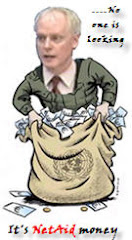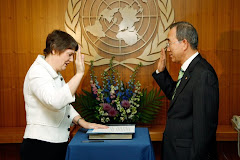 The United Nations Development Programme is the leading agency for ensuring the implementation of Millennium Development Goals (MDGs).
The United Nations Development Programme is the leading agency for ensuring the implementation of Millennium Development Goals (MDGs).MDGs are eight goals to be achieved by 2015 that respond to the world's main development challenges. The MDGs are drawn from the actions and targets contained in the Millennium Declaration that was adopted by 189 nations-and signed by 147 heads of state and governments during the UN Millennium Summit in September 2000. These goals are:
Goal 1: Eradicate extreme poverty and hunger
Goal 2: Achieve universal primary education
Goal 3: Promote gender equality and empower women
Goal 4: Reduce child mortality
Goal 5: Improve maternal health
Goal 6: Combat HIV/AIDS, malaria and other diseases
Goal 7: Ensure environmental sustainability
Goal 8: Develop a Global Partnership for Development
When arrived in office in January 2007, Ban Ki-moon the current UN's Secretary General said that: "The MDGs are still achievable if we act now. This will require inclusive sound governance, increased public investment, economic growth, enhanced productive capacity, and the creation of decent work."
UNDP's role in MDGs was to work with a wide range of partners help create coalitions for change supporting the goals at global, regional and national levels, to benchmark progress towards them, and to help countries to build the institutional capacity, policies and programmes needed to achieve the MDGs.
Guided by the UN Core Strategy, UNDP's work on the MDGs focuses on coordinating global and local efforts that:
- Campaign and mobilise for the MDGs through advocacy;
- Share the best strategies for meeting the MDGs in terms of innovative practices, policy and institutional reforms, means of policy implementation, and evaluation of financing options;
- Monitor and report progress towards the MDGs; and
- Support governments in tailoring the MDGs to local circumstances and challenges.
But let's cut the crap and lies of UNDP's auto-publicity and publish today a simple chart of what have UNDP achieved in the past 20 years in fight against poverty. What better than comparing the lists of Least Developed Countries (LDC) and see how much have UNDP assistance in the past 20 years helped reduced this list and assit UN Member States to their road to development.
As you will notice United Nations Development Programme instead of reducing the list of LDCs in 1989 which was composed of 41 countries, UNDP instead ruined the lives and put into poverty 9 more countries and increased the list of LDCs to 50 countries.
Least Developed Countries (LDC) 1989
Total number: 41
Afghanistan
Bangladesh
Benin
Bhutan
Botswana
Burma
Burundi
Cape Verde
Central African Republic
Chad
Comoros
Djibouti
Equatorial Guinea
Gambia
Guinea
Guinea-Bissau
Haiti
Kiribati
Laos
Lesotho
Malawi
Maldives
Mali
Mauritania
Mozambique
Nepal
Niger
Rwanda
Samoa
Sao Tome and Principe
Sierra Leone
Somalia
Sudan
Tanzania, United Republic of
Togo
Tuvalu
Uganda
Upper Volta
Vanuatu
Yemen
Yemen, Democratic
Least Developed Countries (LDC) 2006
Total number: 50
Afghanistan
Angola
Bangladesh
Benin
Bhutan
Burkina Faso
Burundi
Cambodia
Cape Verde
Central African Republic
Chad
Comoros
Congo, Democratic Republic of
Djibouti
Equatorial Guinea
Eritrea
Ethiopia
Gambia
Guinea
Guinea-Bissau
Haiti
Kiribati
Laos
Lesotho
Liberia
Madagascar
Malawi
Maldives
Mali
Mauritania
Mozambique
Myanmar
Nepal
Niger
Rwanda
Samoa
Sao Tome and Principe
Senegal
Sierra Leone
Solomon Islands
Somalia
Sudan
Tanzania, United Republic of
Timor-Leste
Togo
Tuvalu
Uganda
Vanuatu
Yemen
Zambia
















































1 comment:
Maternal and child Health is of utmost importance.
Its startling to know that more than half a million women die in pregnancy and childbirth
every year - that's one death every minute. I also came across a community on orkut which
represents the UN campaign against poverty of which child and maternal health is one of
the 7 major goals.
Post a Comment